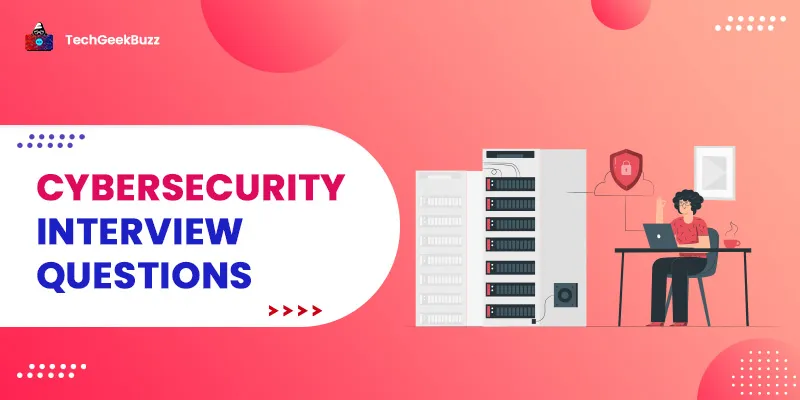With new technologies being developed daily, the frequency of cyberattacks is also significantly rising. As the risk of cyber threats is growing, companies and organizations need to prioritize cybersecurity. Though many people think of cybersecurity as a problem, it is of the utmost importance for every organization and individual with an online presence.
Cybersecurity is a method of protecting systems, networks, applications, and all other internet-connected programs from digital attacks or cyber threats. In other words, we can say that cybersecurity is a practice that organizations, companies, and even individuals employ to protect their sensitive information from unauthorized access.
Now, it is bound to arise one question in your mind what exactly does a cyber threat mean? Does it solely refer to unauthorized access to data? Or is it something more than that?
If you want to explore what a cyber threat is, what are its causes, and its different types, we have got you covered.
This article will walk you through everything you need to know about cyber threats.
What is a Cyber Threat?
It is any intentional or purposeful event an individual or organization carries out with the objective of stealing, harming, or disrupting the IT asset, computers, networks, and other computing systems of another person or organization.
Alternatively, we can define a cyber threat as any hostile act the hackers or cyber criminals perform with the intent to steal, damage, and corrupt data and disturb the entire digital life.
Cyber threats may source from any trusted individual within an organization, such as an employee, or unknown individuals from remote locations, such as hackers and criminal groups.
Sources of Cyber Threats
In order to prevent cyber threats or protect computing devices from cyber threats, it is first essential to know about threat actors and their intentions. The following are some of the typical sources from where cyber threats originate:
-
Hackers
They are malicious intruders that leverage the zero-day (0-day) vulnerability, which is a security vulnerability unknown to the developers of hardware or software, to access any computer system or network unauthorizedly.
The primary intent of hackers could be personal gain, financial gain, sometimes revenge, or stalking. Also, they may want to strengthen their criminal abilities or grab a position in the hacker community.
Earlier, breaking into other systems without permission required a high level of expertise. However, the more sophisticated and complex cyber-attacks have become simple with automated scripts and protocols available readily online.
-
Nation-States
Nation-states are hostile countries that introduce cyber attacks against government agencies, local companies, institutions, and any industry with the aim to create interference in business operations, extensive data and revenue loss and expose confidential information using more sophisticated techniques and practices.
-
Criminal Groups
A criminal group involves multiple hackers with the intent to access the computing systems or networks unauthorizedly for financial gain. To break into systems or networks, criminal groups leverage malware, spyware, online scams, phishing, and stealing confidential information.
-
Terrorist Organizations
Terrorist organizations are bodies that aim to threaten the security of a nation, disturb the nation’s economy, damage and destroy military equipment, exploit critical and sensitive infrastructure, and harm citizens.
-
Malicious Insiders
As its name suggests, malicious insiders are employees, contractors, partners, or suppliers, within an organization. They misuse their privilege of legitly accessing the organization’s IT asset with the purpose of damaging it for personal or financial gain. As insiders have authorized access to the organization’s sensitive data, they do not require any technical expertise.
Popular Types of Cyber Threats
In order to protect sensitive data, computing systems, and networks from cyber threats, it is essential first to know their types and intentions. The following are some of the typical types of cyber threats:
1. Malware Attacks
The term ‘malware’ is the combination of malicious and software. It is basically software developed purposefully to compromise the security of computer systems, networks, servers, and other computing devices to access and leak information unauthorizedly or prevent actual users from accessing information.
Malware is one of the most common types of attacks that include spyware, trojans, worms, viruses, and ransomware. Hackers can introduce malware into your system through a malicious link, unwanted software download, email, or an unreliable website.
When malware infects your system, it can steal, alter, or destroy sensitive data, prevent you from accessing it, or even cause your system to crash.
The following are some common forms of malware attacks:
-
Worms
A worm is a form of malware that copies itself and spreads throughout the computer system. It takes advantage of the security weaknesses of your system and installs a backdoor to steal or corrupt confidential information, corrupt files, and perform other harmful activities.
-
Trojans
A Trojan Horse or Trojan is a piece of code that appears legitimate and is hidden inside applications, games, or email attachments. It infiltrates your system with the primary purpose of corrupting, harming, and destroying critical information and performing other malicious actions.
-
Ransomware
Ransomware is another type of malware with the primary intention of denying the users or organizations from accessing their own systems and files through encryption. The attacker further demands the victim to pay the stated amount in order to restore access to the system and files. However, there is no assurance that the attacker will do so even after paying the amount.
-
Viruses
A virus is a computer program or malicious code that manipulates the way a computer functions and spreads from one computer to another. When executed, a virus replicates by inserting or attaching its code to other legit programs of the system.
-
Spyware
Spyware is also a computer program or software installed on a computer without the knowledge of its owner and keeps track of online activities to collect personal data, such as login credentials. Later, it passes on the data to other parties with the aim of harming the victim.
-
Adware
Adware is software that displays unwanted pop-up advertisements on your mobile device or computer system, especially in the browser. It is not necessary that adware is always used for malicious activities. But, it comprises the security of your system. Generally, adware monitors your online activities to identify your interests and conveys the same to the advertiser to send the target ads.
-
Cryptojacking
It is a kind of malware that hackers deploy on the victim’s system without their knowledge and leverages computing power to generate cryptocurrency. It is basically hijacking the victim’s system to mine cryptocurrencies without the knowledge of the victim.
2. Social Engineering Attacks
Social engineering is a psychological technique to trick the victim into making errors and then gaining personal information or installing malware on the victim’s system unknowingly. Here, attackers seem to be legitimate because first, they gain the trust of the victim and later encourage the victim to take actions that make the system susceptible to attacks.
Like malware, the social engineering attack is also an umbrella term that encompasses several attacks, as follows:
-
Phishing
The goal of this kind of social engineering attack is to trick the victim into disclosing personal information or allowing the installation of malicious software (malware) on their computer. Hackers try to end such fraudulent messages or emails to as many people as they can or even target some specific ones.
Spear phishing is a form of phishing that targets certain users, while whaling targets high-value people, such as CEOs.
-
Pretexting
In this type of social engineering assault, the threat actors try to persuade victims to divulge their sensitive information or access their system by making up a false story or scenario. At the time of the attack, threat actors ask victims about their personal information and state that they need it for confirming the target’s identity.
-
Vishing
Voice phishing is referred to collectively as "vishing." Threat actors generally make fraudulent phone calls or leave voice messages to deceive victims, obtain their private information, or access their systems.
-
Smishing
Smishing is SMS phishing where imposters send fraudulent text messages to trick targets into clicking a malicious link or downloading a malicious software on their systems with the aim to access their systems and steal personal data.
-
Tailgating
It is a technique that threat actors use to sneak into the restricted areas immediately after the authorized users have entered them. This means that unauthorized users follow authorized users unknowingly. In general, it is a physical security breach with the aim to enter a protected area.
-
Piggybacking
Like tailgating, piggybacking is also a physical security breach. The only difference is that, in piggybacking, imposters access a secured area with the permission of the authorized users.
-
Baiting
Baiting is another type of social engineering attack where imposters entice victims by promising to offer something attractive in exchange for their private information or granting access to their systems.
3. Man-in-the-Middle (MitM) Attack
As its name suggests, the man-in-the-middle attack entails interrupting the communication between two parties, such as an application and end-users. The threat actors covertly introduce themselves in the communication between two parties and have entire control over their conversation. They impersonate both parties so that each of them believes they are sending and receiving messages from a legitimate person.
The following are some of the examples of MitM:
-
Email Hijacking
It is a type of MitM where the threat actors succeed in gaining the access to the email address of a legit organization or individual. Once they gain access to the victim’s email address, hackers can send emails to the target’s bank instructing them to transfer the amount to the hacker’s account.
This is one example of email hijacking which leaves victims at a great financial loss. In addition, imposters may gain access to the target’s social media and other online accounts that are linked with the email account.
-
WiFi Eavesdropping
This type of menace involves hackers stealing data when people connect to public and unsecured WiFi networks. Hackers can easily steal anything unencrypted, whether it is a password, financial information, or important files, over unsecured WiFi networks.
Many times, imposters intentionally set up a free WiFi network and give it a trustworthy appearance. In this case, people connect to that network and wind up disclosing their private data to hackers unknowingly.
-
IP Spoofing
This kind of cyber threat entails creating IP packets with an erroneous source IP address that seems to be the legitimate one. In simple terms, hackers hide the actual source of the IP packets so that the users should not know from the packets are arriving. They create new IP packets with a different source IP address that pose to be the legitimate one.
-
DNS Spoofing
DNS spoofing is a cyber menace that exploits the security vulnerability of the DNS server and drives organic traffic from the legitimate server to the fake one. Whenever users try to access the actual website, they get redirected to the one that mimics the original one.
-
HTTPS Spoofing
In HTTPS spoofing, the threat actors use a domain name that seems exactly similar to the target website. What hackers do is replace characters from the target website's domain name with some non-ASCII characters that look similar.
4. Supply Chain Attack
This type of cyber threat has the intent to break the trustworthy relationship between software developers and vendors. In a software supply chain attack, imposters infect the legit applications and manipulate their source code in order to inject malware.
Also, hackers always look for unsecured network protocols, coding techniques, and IT infrastructure to manipulate the source code of applications with malicious code and harm the software build and update process.
This type of attack has very adverse effects on the organizations or vendors and the real users of software products. As hackers infect applications before releasing them in the market, vendors certify those compromised applications and make them live. However, vendors are not aware of the fact that the damage is already done. In such a way, vendors and customers lose their trustworthy relationships.
5. Denial-of-Service Attack
A Denial-of-Service attack aims to shut down the target system or network, making it inaccessible to its users. There are two ways to make the DoS attack successful and that are flooding services and crashing services.
Flooding Services
Hackers accomplish it by flooding the target system with a heavy amount of traffic that becomes impossible for the system to handle and behaves strangely. The following are the popular examples of flood attacks:
- Buffer Overflow: In this attack, threat actors send a lot of traffic to a network address beyond its capacity to handle.
- ICMP Flood: This attack targets all network devices that are not configured correctly by sending spoofed packets to every computer connected over that network. As a result, the ICMP flood attack does not simply target a single machine. Instead, it infects all the systems connected to the target network.
- SYN Flood: This attack entails sending a request to connect to the server but never completes a handshake. It continues doing this until it saturates all the open ports, leaving no port for legitimate users to connect to the server.
Crashing Services
The alternative approach imposters leverage to accomplish the DoS attack is by crashing services. They exploit the weaknesses of the target system by sending an input that results in subsequent crashing of the system so that the users cannot access the resources or services.
In short, this kind of attack does not allow legitimate users to access the required resources or services. When attackers target multiple systems or devices, it is referred to as a Distributed Denial-of-Service (DDoS) attack.
6. Injection Attacks
Injection attacks aim to inject a malicious piece of code into the source code of web applications by exploiting their weaknesses. Such attacks wind up exposing the personal information of a website owner as well as users, compromising the entire web server , or leading to a denial-of-service (DoS) attack.
Some common types of injection attacks are as follows:
-
SQL Injection (SQLi)
In SQLi, attackers use the end-user input channel of a website or web application, such as a web form, input field, or comment section, to enter the malicious SQL query. The vulnerable application accepts the input from the attacker, sends it to the database, and executes the SQL queries injected into the input. This injection of SQL queries can read, write, modify, and even delete the data in the database.
-
Cross-Site Scripting (XSS)
The XSS attack involves the injection of malicious JavaScript code into trusted websites and web applications. When users visit the infected websites or web applications, their browsers execute the injected malicious JavaScript code and get redirected to a malicious website, hijack users’ sessions, or steal cookies.
-
Code Injection
In the code injection attack, attackers exploit the security weaknesses of an application and inject a piece of code into it, which the web server executes considering it as a part of the application. This attack can compromise the entire web server, gain the personal information of users, access sensitive data, and much more.
-
Command Injection
Command injection involves running random commands on the operating system of the host computer. Generally, threat actors leverage the security flaws of any applications hosted on the host computer and execute commands with the intention to cause damage to applications, servers, and systems or steal information.
-
LDAP Injection
LDAP stands for Lightweight Directory Access Protocol. The LDAP injection attack targets websites that construct LDAP queries depending on user inputs. What attackers do is enter the input with the aim of accessing the data stored in the LDAP server.
Cybersecurity Solutions
Since all the aforementioned cyber threats are extremely harmful in that they leave an organization or individual with data as well as financial loss, there is an immense need to adopt cybersecurity solutions to safeguard against them. The following are some of the major types of cybersecurity solutions that organizations should consider:
- Application Security: This cybersecurity solution tests software applications during their development and testing phases to check if there are any security vulnerabilities. It protects applications that run in the production environment from various types of cyber threats.
- Cloud Security : It is a set of processes, technologies, and tools with the primary intent of protecting cloud-based data, applications, services, and infrastructure.
- Network Security : The network security solution intends to keep an eye on network traffic, identify malicious traffic, and assist organizations to protect their networks from different cyber attacks.
- IoT Security : This solution primarily focuses on improving the security of IoT devices. It is basically the practice of protecting the internet-based devices and networks to which they are connected from potential cyber attacks.
- Threat Intelligence: It is the information that assists organizations in determining the kind of threat that hackers can target or are currently targeting.
- Endpoint Security: It is a practice of protecting the end point of end-user devices, such as desktops, laptops, or mobile phones, from potential cyber threats.
Conclusion
This concludes our take on the discussion of cyber threats. A cyber threat is any event or act the attackers perform on applications, networks, and IT infrastructure of organizations with the intent to steal data and disrupt, damage, and destroy IT assets. To avoid such damage to networks and computers and prevent data loss, cybersecurity solutions come in handy.
Not only hackers target computer systems, networks, or IT infrastructure but also mobile devices. Here is what you need to know: why should you take smartphone cybersecurity seriously.
People are also reading:



![What is Cybersecurity? [Definition, Importance, Types, Challenges]](/media/new_post_images/What-is-Cybersecurity.webp)

Leave a Comment on this Post